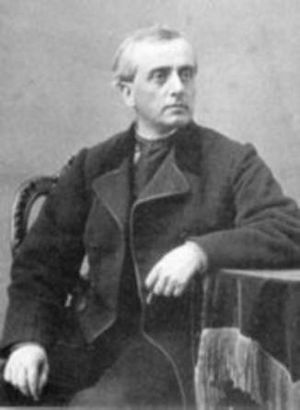Giuseppe Fiorelli facts for kids
Giuseppe Fiorelli (born June 7, 1823 – died January 28, 1896) was an Italian archaeologist. He is famous for his important work at the ancient city of Pompeii. His efforts helped to save and understand this amazing historical site.
Contents
Giuseppe Fiorelli's Life
Giuseppe Fiorelli was born in Naples on June 7, 1823. He started working at Pompeii in 1848. Later, he was put in prison for a while. This happened because his new ideas about archaeology and his strong feelings for Italy's independence caused problems with the king, Ferdinand II.
While he was in prison, Fiorelli wrote a three-volume book. It was called History of Pompeian Antiques. After Italy became a united country in 1860, Fiorelli became a professor at Naples University. He also became the director of the Pompeii excavations from 1860 to 1875. At the same time, he directed the Naples National Archaeological Museum starting in 1863.
New Ways to Explore Pompeii
When Italy united in 1860, Pompeii became property of the state. Before this, the king owned Pompeii. He could take ancient items for his own collection or give them to important visitors. Fiorelli was made the superintendent. He started to manage the excavations differently. He wanted Pompeii to be a place where people could visit. They could learn about the past and understand ancient Western civilization.
Fiorelli created a system to identify every building in the old city. He also focused on carefully copying and listing the wall paintings (frescoes) that were found. In 1870, Fiorelli asked Geremia Discanno to start copying the frescoes. Discanno's detailed drawings were listed in Fiorelli's 1873 book, "The excavations of Pompeii from 1861 to 1872."
Fiorelli's Excavation Method
As the director of the Pompeii excavation, Fiorelli brought in a completely new system. Before, workers would uncover the streets first. Then they would dig out the houses from the ground floor up. Fiorelli changed this. He made them uncover the houses from the top down. This was a much better way to protect everything they found.
This new method helped a lot. The information collected during digging could be used to fix the ancient buildings. It also helped restore their insides. Even so, the most important wall paintings and mosaics were still taken out. They were moved to Naples for safekeeping. Fiorelli also divided the town into specific areas. These areas are still used today to refer to different parts of Pompeii.
The Famous Plaster Casts
Fiorelli is most famous for his plaster casts. These are made using a special method named after him: the Fiorelli process. He noticed that when a body or other organic material was buried in ash, it would rot away over time. This left an empty space or cavity in the hardened ash.
Whenever workers found such a cavity, they would pour plaster of Paris into it. They would let the plaster harden. Then, the ash around the plaster was carefully removed. What was left was a plaster copy of a person or animal. It showed them exactly as they were at the moment they died. This process gave amazing information. It showed how people died during the eruption. It also revealed what they were doing in their last moments and what clothes they wore.
Sharing Knowledge and Later Years
Fiorelli was known for welcoming scholars from other countries. He started a training school. Both Italians and foreigners could learn archaeological techniques there. He also studied the materials and building methods used in Pompeii. Many famous scholars came to study Pompeii during his time. One of them was August Mau in 1882. Mau created a system to categorize Pompeian paintings into different decorative styles. Mau's work is still used today to study these ancient Roman paintings.
In 1875, Fiorelli became the director general of Italian Antiquities and Fine Arts. He held this important job until he passed away twenty years later. His work at Pompeii was continued by others. They began to restore the roofs of the houses with wood and tiles. This helped protect the remaining wall paintings and mosaics inside.
Fiorelli died on January 28, 1896, in Naples.
See also
 In Spanish: Giuseppe Fiorelli para niños
In Spanish: Giuseppe Fiorelli para niños


